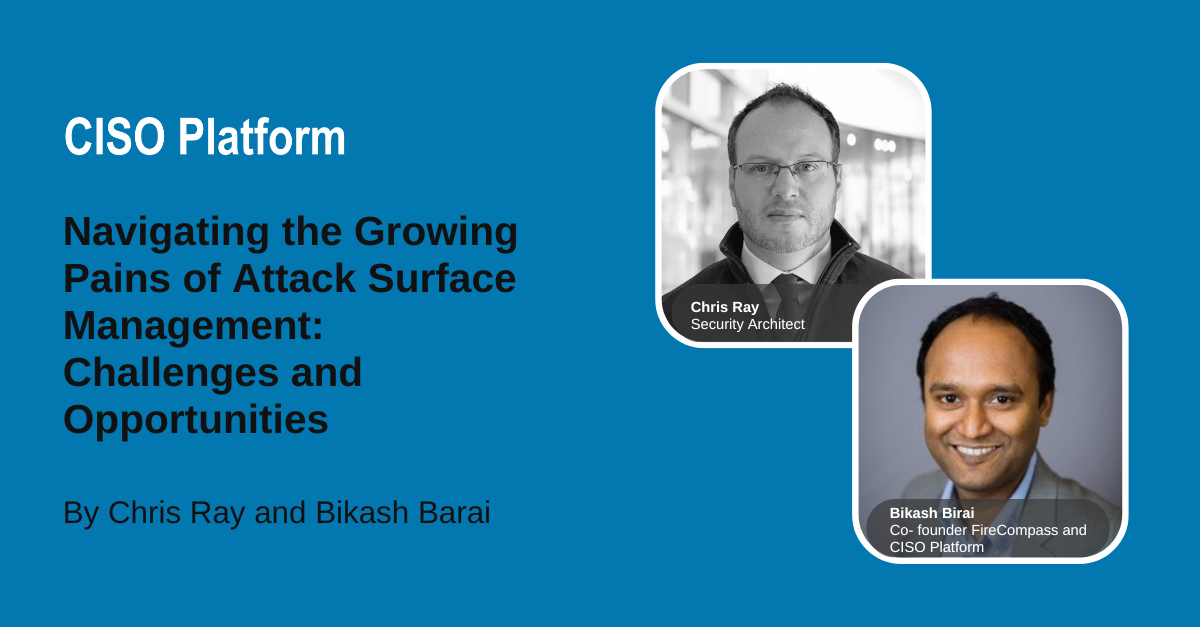In the ever-evolving landscape of cybersecurity, Attack Surface Management (ASM) emerges as a crucial cornerstone for organizations seeking to fortify their defenses against emerging threats. ASM transcends traditional boundaries, intersecting with multiple personas and technology domains to provide comprehensive insights into an organization's attack surface. However, despite its undeniable potential, ASM faces a myriad of challenges as it navigates the complexities of a rapidly evolving cybersecurity landscape. In this blog, we delve into the growing pains of ASM, exploring the challenges, opportunities, and nuances that define its journey towards maturity.
Here is the verbatim discussion:
Inventory you can't do vulnerability management uh the security leadership as you mentioned they're using this so it cuts across kind of multiple personas and if you look at if you look at the technology domains where ASM fits in that's also is very kind of horizontal right like for example vulnerability management and obvious area um uh but along with that if you look at Cloud security and that's the reason why some of the cloud security posture management cspm companies acquired ASM huh so um so there's a kind of augmentation story out there with threat intelligence there's an augmentation story because just the threat Intel without the context I mean it's good but it's not good enough if somebody could tell you well here's this adversary and these are their ttps and you got like 10 assets which could be interesting from that perspective so uh so I think TI and ASM also is getting converged because there's a nice augmentation Story the sock and ASM also has got an augmentation story because the the ASM can find out the assets and tell the sock that here's open RDP Port this faces because it is kind of it has become a hot new technology but it's still kind of early days not not at the super mature stage right so what what are those uh kind of growing pains? What are the challenges which ASM as an industry is facing today?What are the bad sides?
Highlights:
Horizontal Integration Across Personas and Domains: ASM spans across multiple personas and technology domains, making it a versatile tool for security leadership, vulnerability management teams, cloud security practitioners, threat intelligence analysts, and security operations centers (SOCs). Its horizontal integration enables organizations to gain holistic visibility into their attack surface, empowering them to make informed decisions and prioritize remediation efforts effectively.
Convergence with Cloud Security and Threat Intelligence: The convergence of ASM with cloud security posture management (CSPM) and threat intelligence (TI) heralds a new era of augmentation and synergy. ASM augments cloud security efforts by identifying misconfigurations and vulnerabilities within cloud environments, while also enriching threat intelligence with contextual insights into potential adversary tactics, techniques, and procedures (TTPs). This convergence unlocks new avenues for proactive defense and threat mitigation, bridging the gap between traditional security silos and fostering collaboration across disciplines.
Navigating the Growing Pains: Despite its promising trajectory, ASM grapples with several growing pains on its journey towards maturity. Challenges such as false positives, alert fatigue, integration complexities, and the need for context-aware analysis pose significant hurdles for organizations adopting ASM solutions. Moreover, the nascent stage of ASM as a technology domain necessitates ongoing refinement and innovation to address evolving threats and emerging attack vectors effectively.
As ASM emerges as a hotbed of innovation and potential within the cybersecurity landscape, it is essential to acknowledge and address the growing pains that accompany its evolution. By confronting challenges head-on and leveraging opportunities for convergence and collaboration, organizations can harness the full potential of ASM to fortify their defenses and stay ahead of emerging threats. Through proactive measures, continuous refinement, and a collaborative approach to cybersecurity, ASM stands poised to mature into a foundational pillar of modern cybersecurity operations. As organizations navigate the complexities of an increasingly digital world, ASM serves as a beacon of resilience, empowering them to safeguard their digital assets and embrace a future of secure and sustainable cybersecurity practices.
Speakers:
Chris Ray, a seasoned professional in the cybersecurity field, brings a wealth of experience from small teams to large financial institutions, as well as industries such as healthcare, financials, and tech. He has acquired an extensive amount of experience advising and consulting with security vendors, helping them find product-market fit as well as deliver cyber security services.
Bikash Barai is credited for several innovations in the domain of Network Security and Anti-Spam Technologies and has multiple patents in USPTO. Fortune recognized Bikash among India’s Top 40 Business Leaders under the age of 40 (Fortune 40-under-40).Bikash is also an active speaker and has spoken at various forums like TiE, RSA Conference USA, TEDx etc.
Earlier he founded iViZ an IDG Ventures-backed company that was later acquired by Cigital and now Synopsys. iViZ was the first company in the world to take Ethical Hacking (or Penetration Testing) to
the cloud.


Comments